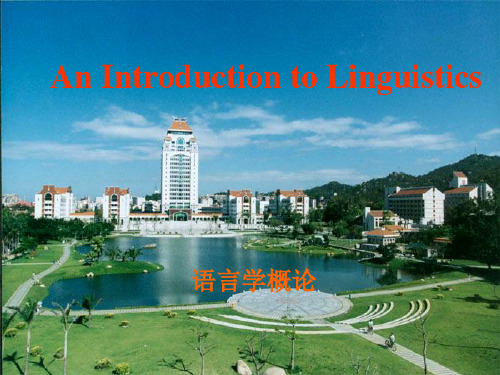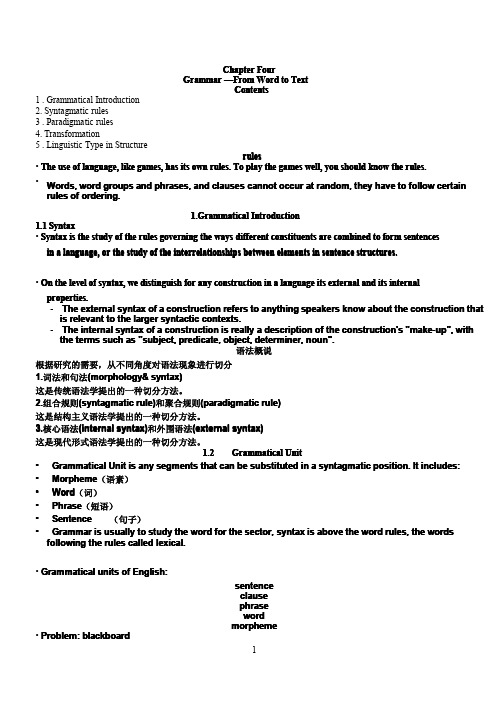语言学讲义4
- 格式:ppt
- 大小:701.50 KB
- 文档页数:70



Chapter FourGrammar—From Word to TextContents1.Grammatical Introduction2.Syntagmatic rules3.Paradigmatic rules4.Transformation5.Linguistic Type in Structurerules•The use of language,like games,has its own rules.To play the games well,you should know the rules.•Words,word groups and phrases,and clauses cannot occur at random,they have to follow certain rules of ordering.1.Grammatical Introduction1.1Syntax•Syntax is the study of the rules governing the ways different constituents are combined to form sentences in a language,or the study of the interrelationships between elements in sentence structures.•On the level of syntax,we distinguish for any construction in a language its external and its internal properties.-The external syntax of a construction refers to anything speakers know about the construction that is relevant to the larger syntactic contexts.-The internal syntax of a construction is really a description of the construction's"make-up",with the terms such as"subject,predicate,object,determiner,noun".语法概说根据研究的需要,从不同角度对语法现象进行切分1.词法和句法(morphology&syntax)这是传统语法学提出的一种切分方法。



语言学概论课程讲义目录及部分课程讲义《语言学概论》课程目录第一章语言和语言研究第一节语言和语言学一、语言的内涵与外延二、语言的若干属性三、语言学第二节语言功能一、社会文化方面的功能二、心理方面功能第三节语言历史一、语言起源二、语言分化三、语言的接触和融合四、语言发展的原因和特点第四节西方语言学简史一、传统语言学二、历史比较语言学三、现代语言学四、当代语言学第二章语言结构第一节语言的结构系统一、语言的层级与层面二、语言结构的共性和个性三、语言结构类型第二节语音一、语音和语音学二、音素和音位三、语音特征四、语音组合第三节语义一、语义和语义学二、语义单位三、义素分析四、语义场五、语义的组合第四节语汇一、语汇和语汇学二、语汇层级三、语汇聚类四、语汇构成第五节语法一、语法和语法学二、语法形式和语法意义三、词类四、短语五、句子六、语段第三章语言运用第一节言语交际一、语言运用与语用学二、言语交际的过程三、言语交际的原则四、言语交际的制约因素第二节言语行为一、言语行为的概念二、言语行为的类型三、间接言语行为第三节话语表达和话语理解一、话语表达二、话语理解第四节交际变体和语用对策一、交际变体二、语言交际障碍三、社会语用对策第四章语言学习第一节第一语言获得一、第一语言获得理论二、儿童语言的发展第二节第二语言获得一、第二语言获得理论二、中介语三、对比分析和偏误分析四、第二语言教学法附录世界语言谱系分类表参考文献语言学概论课程名称:语言和语言研究(一)教学目标:掌握语言的内涵和外延;知识点:语言与言语、口语与书面语、共同语与方言、自然语言与其他符号系统重难点:语言与言语、自然语言与其他符号系统课程内容:第一章语言和语言研究第一节语言和语言学一、语言的内涵与外延(一)语言是什么语言学界至今对语言还没有一个清晰而统一的定义。
因为不同的时代、不同的学派对语言有不同的看法。
一般来说,可以把语言定义为:人类用于交际和思维的最重要的符号系统。
Chapter 4 MorphologyT eaching aims: let the students have a brief knowledge about morphemes and the basic word-formation methodsFocal points: definition and classification of morphemes; major word-formation methodsTeaching procedure:The outline of the chapter:1 Morphology1.1 concept p521.2 word1.2.1 concept1.2.2 identification P571.2.3 classification2 Morpheme2.1 Concept: P52.2.2 Types of Morpheme2.2.1 Free morphemes and Bound morphemes:2.2.2 Root, affix and stem(P 53)2.2.3 Inflectional morpheme and derivational morpheme(P63)3 Internal structure of words3.1 mono-morphemic words3.2 poly- morphemic words3.3 compounds4 Word formation4.1 Major ways to create new words:4.2 Minor ways to create new words:1 Morphology1.1 concept p521.2 word571.2.1 concept1) wordWord is a typical grammatical unit between morpheme and word group. e.g. It is kind of you ,Miss Hou. Every word plays a grammatical part in the sentence.2)lexical items see p571.2.2 identification P57(how to recognize words?)1)stability2) relative uninterruptibility3) a minimum free form1.2.3 classification1.2.3.1 words1) Variable vs. invariable words(1) criterion: whether they have inflective changes(2) classification: variable vs. invariable words2) Grammatical words vs. lexical words(1) criterion: whether they work for constructinggroup,phrase…, or referring to substance…(2) classification: grammatical words vs. lexical words3)Content words vs. function words(1) criterion: whether they carry the main content(2) classification: content words vs. function words4) Closed-class words vs. open-class words(1) criterion: whether their membership is limited or unlimited(2) classification: Closed-class words vs. open-class words1.2.3.2 word class(1) criterion: classify words by grouping them into classesaccording to their formal similarities(2) classification: 2 classes; 9 classes; 13 classes2 Morpheme2.1 Concept: P61.2.2 Types of Morpheme2.2.1 Free morphemes and Bound morphemes1) criterion: whether they may ocurr alone2) types(1) Free morphemes : morphemes which may constitute wordsby themselves(2) Bound morphemes: morphemes which can not be used bythemselves, but must be combined with other morphemes toform words2.2.2 Root, affix and stem(P 62)1) root2) affix3) stem2.2.3 Inflectional morpheme and derivational morpheme(P63)3 Internal structure of words3.1 mono-morphemic words3.2 poly- morphemic words3.3 compounds4 Word formation4.1 Major ways to create new words:1) Compounding: a process of combining two or more words intoone lexical unit.blackboard godfather baby-sit cross-cultural2)Derivation: the process by which new words are formed by theaddition of affixes to the roots or words. e.g.finalize widen hospitalize clockwise (顺时针)3)Conversion( Class shift)4.2 Minor ways to create new words:1) invention2)Blending : a process of forming a new word by combiningparts of other words.smog(smoke+fog); brunch smaze(smog+haze);telecast(television+ broadcast); motel (motor +hotel)3)Clipping: a shortened form of a word or phrase which representsthe complete form.e.g. TV(television) Dr(doctor) hr(hour) ft(foot or feet)clipping: a kind of abbreviation of longer words or phrasese.g. telephone---phone memorandum---memoelectronic mail---e-mail high fidelity---hi-fi4)Acronym: a word created by combining the initial letters of anumber of words.e.g. UNESCO APEC Sars CD laser radar (radio detectingand ranging) Initialism: VOA BBC WTO5)Back-formation: a process by which new words are formed by taking away the suffix of an existing word.televise (from television) donate (from donation) enthuse (from enthusiasm)6)Borrowing: the taking over of words from other languages。
导言部分一、语言学:以语言为研究对象的科学、研究探索语言的本质、结构和发展规律。
二、语言的三大发源地:中国、印度、希腊-罗马三、小学:小学是我国古代语文学的统称,由训诂学、文字学、音韵学组成。
四、语言交际的过程:编码-发送-传递-接受-解码五个阶段。
五、根据研究对象的不同把语言学分为专语语言学和普通语言学。
五、1共时语言学:以同时的静态分析的方法、研究语言相对静止的状态。
描写分析语言在某一个时期、某一个阶段的状况,时从横的方面研究语言。
(如现代汉语、当代英语)五、2历时语言学:从历时的、动态的角度研究语言发展的历史,观察一种语言的各个结构要素在不同发展阶段的历史演变,是从纵的方面研究语言的历史。
(如汉语史)五、3专语语言学:又称具体语言学、个别语言学,是以一种或几种有联系的语言为研究对象,研究某一语言的结构。
五、4普通语言学:以人类一般语言为研究对象,研究人类语言的性质、结构特征、发展规律,是综合众多语言研究成果而建立起来的。
五、5现代语言学之父:瑞士索绪尔代表作《普通语言学教程》六、语言学流派:1历史比较语言学:是比较方言或亲属关系语言的这种成系统的差异,重建语言史的一门学科。
历史比较语言学在语言学史上具有重要地位:历史比较语言学,为后来的结构主义和描写语言学的产生和发展创造了有利条件,它在19世纪进入了系统的研究,是语言学走上独立发展道路的标志。
历史比较语言学代表人物:初期:丹麦拉斯克;中期:德国施莱歇尔2、结构语言学的分支:布拉格学派、哥本哈根学派、美国描写语言学派。
美国描写语言学代表人物:布龙菲尔德代表作《语言论》七、语言的三要素:主要是语音、词汇和语义、语法三部分第一章语言的功能第一节语言是人类最重要的交际工具一、语言是音义结合的符号系统,是人类最重要的交际工具和思维工具。
一、1语言的作用:语言是人类社会的交际工具,每个社会无论经济发达还是落后,都必须有属于自己的语言,都离布开语言这个交际工具。